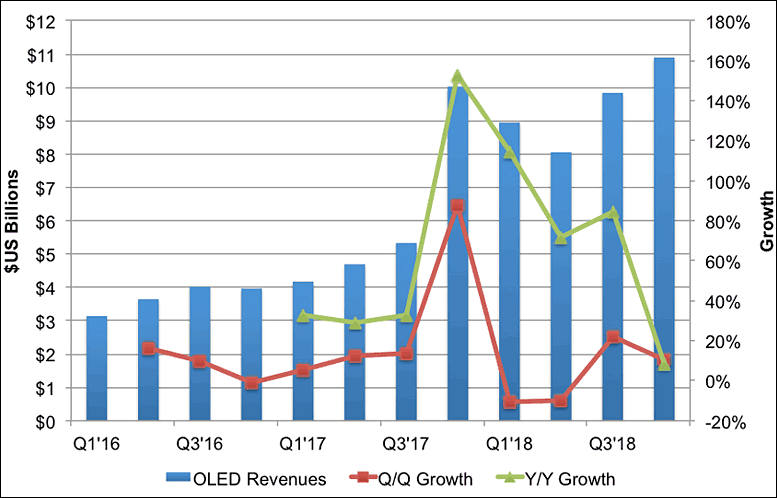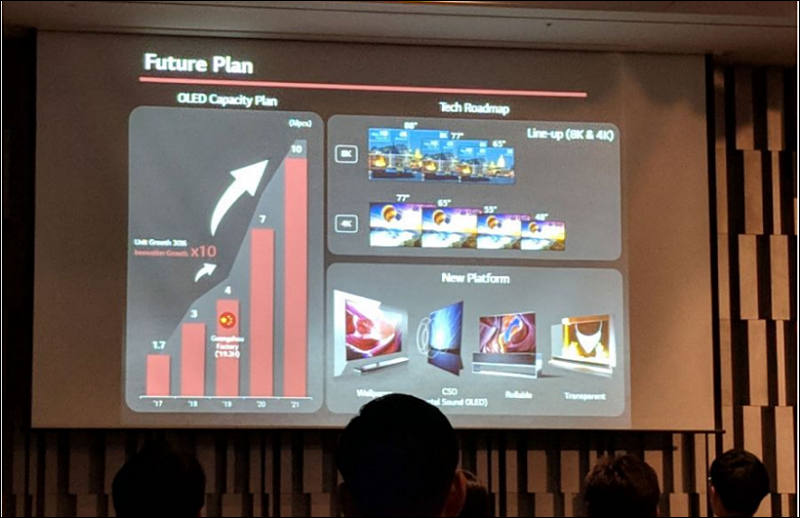
It allows to keep PV going, with more focus towards AI, but keeping be one of the few truly independent places.
-
Yes, but their main competitor in TVs is LG :-) And they do not use any OLED in TVs.
Idea here is that in phones usage is much lower compared to phones, so degradation is low and acceptable.
-
Use of OLED panels in TVs is on the rise, and the proportion of OLED models will keep rising to 68% in 2020, especially dominating high-end TV segment, according to the Photonics Industry & Technology Development Association (PIDA).
Optimistic view.
-
Interesting graphs. Is there any indication of the scale?
-
LG 65-inch Signature Series E7P OLED TV won best television for 2017 for studio lighting/home theater, HDR viewing and for streaming video presentation. This marked the fourth consecutive year an LG OLED TV had come out on top in voting during the Shootout event.
Shootout was organized and licensed by CE Week management with the blessing of “TV Shootout” event creator Robert Zohn, proprietor of the Scardsdale, NY-specialty retail chain Value Electronics,
-
I guess we will see more consecutive years of LG OLED TVs winning this contest - until finally some other vendor becomes able to produce large high-resolution TVs with actively light emitting pixels at reasonable prices.
And only then prices for OLED-TVs will fall dramatically to a level nea their actually low production cost.
-
And only then prices for OLED-TVs will fall dramatically to a level nea their actually low production cost.
It is one big thing that also holds OLED production. As at real mass production they kill two things - visible difference among premium and cheap line, and huge price premium for larger sets.
LG and Samsung are not really sure that to do, as by going with progress they could not survive it and it'll be other firms who will get all benefits.
-
LG Display will double its OLED TV panel production capacity to 120,000 substrates a month in 2019, when its new 8.5G production line in Guangzhou, China comes online, according to a Korea-based Seoul Forum report.
Sony plans to double its purchases of OLED TV panels from LGD to 600,000 units in 2019, up from 300,000 units in 2017.
LGD currently has a production capacity of 30,000 OLED substrates a month, including 8,000 units from its E3 fab and 26,000 units each from its E4-1 and E4-2 fabs. Meanwhile, the Guangzhou 8.5g fab has a capacity of 60,000 substrates.
Global shipments of OLED TVs are expected to reach 6.6 million units in 2021, up from 723,000 units in 2016.
-
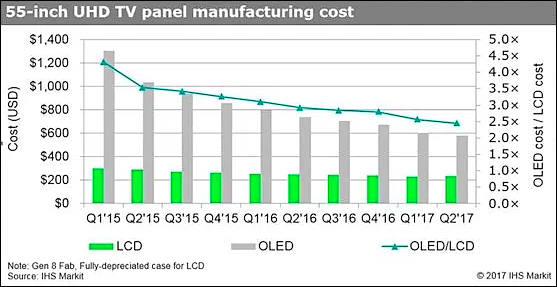
A new IHS analysis on the “OLED Display Cost Model” estimates that the total manufacturing cost of a 55-inch OLED 4K Ultra HDTV panel averaged $582 per unit in the second quarter of 2017, which reflects a 55 percent drop from costs associated with the 4K UHD OLED televisions at the start of 2015.
The cost is expected to decline further to $242 by the first quarter of 2021, IHS Markit said.
Kim said it’s not just the cost of materials that determines the cost gap. In fact, when a 55-inch UHD OLED TV panel costs are 2.5 times more than a comparable LCD TV panel, the gap in the material costs is just 1.7 times. Other contributing factors include production yield, utilization rate, depreciation expenses and substrate size.

 sa369.jpg557 x 287 - 34K
sa369.jpg557 x 287 - 34K -
LG OLED prices for BF time
Active to Nov. 27th.
- $1499 55B7A OLED TV https://www.amazon.com/dp/B073K3LPGF/
- $2299 65B7A OLED TV https://www.amazon.com/dp/B073K7ZFNF/
-
LG will focus on premium buyers
LG Display is expected to shift the focus of its OLED TV panel production to 65- and 77-inch models in 2018 compared to the previous focus of 55- and 65-inch models.
Main idea is to significantly increase margins, big role in this will play HDR focused marketing.
-
Increasing shipments of OLED TVs from LG Electronics, Sony and other vendors in China have brought the downturn for Samsung's TV shipments, the sources noted. OLED TV shipments surged to 745,000 units in the fourth quarter of 2017, up from 218,000 units shipped in the first quarter of the year, according to IHS Markit.
Shipments of the OLED models in the high-end TV segment will remain robust in 2018, with their share in the segment to reach over 60% in the year, the sources estimated.
-
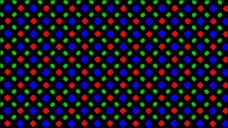
 sa4073.jpg717 x 403 - 80K
sa4073.jpg717 x 403 - 80K -
Sales are small still
Large-size OLED panels exceeded 1.3 million units in the first half of 2018, which more than doubles the sales of 0.6 million units of large-size OLED panels in the first half of 2017.
LG Display said it expects to maximize production efficiency in order to sell more than 2.9 million units of large-size OLED panels this year compared to 200,000 units in 2013 and 1.7 million units in 2017.
-
LG has issues
South Korean-based LG Display reported its second-consecutive quarterly loss as revenue tumbled due to falling panel prices and weaker demand from LCD television and mobile device makers.
LG Display, which is a leading display panel resource for Apple, reported an operating loss of 228 billion won ($202.1 million) in the quarter as revenue fell 15% to 5.6 trillion won, from the same period in 2017.
-
LG B8PUA Series 55"-Class HDR UHD Smart OLED TV, $1596
https://www.bhphotovideo.com/c/product/1411164-REG/lg_oled55b8pua_55_b8pua_4k_hdr.html
-
China's Boe Technology Unveils Large Inkjet-Printed OLED Display to Break Korean Grip
Nov. 26 -- Boe Technology has released an organic light-emitting diode display it says will break South Korea's monopoly in the field of large-sized OLED panels. The Beijing-based ( company) has developed China's first 55-inch 4K OLED display using inkjet printing technology, it said in a statement today. LG Display is currently the world's only supplier of large-sized OLED panels for televisions.The popularity of these panels has been hit by high costs. In order to surmount the problem, Chinese and Korean companies have been actively setting up a layout for inkjet printing technology. The new technology's prospects in the large-sized OLED display sector are promising as inkjet printing know-how can boost the rate at which organic materials are utilized and cut costs.Boe Technology's version uses the RBG full printing technology, with a contrast ratio of one million to one and a wide array of 96.8 percent NTSC (National Television System Committee, an analog television color system). During manufacturing, the organic material utilization rate hits 90 percent, helping to keep down the costs linked to equipment and consumables, Yicai Global learned.The worldwide supply of OLED panels for TVs is still tight despite LG Display investing more in recent years. Although Samsung, another South Korean giant, has about 90 percent of the global market for small- and medium-sized OLED displays, its production of large displays has faced difficulties. -
LG postpone OLED factory
At the end of 2015, LG Display proudly announced the construction of a new generation 10.5 plant in Paju, South Korea - the largest in the group - for an investment of $ 8.7 billion (about $ 7.65 billion). euros). This facility was to produce large Oled slabs as well as LCD slabs. In particular, he had to focus on 65-inch slabs with the ability to produce eight Oled 65-inch slabs per slab. In comparison, LG Display's current 8.5-generation plant uses just six 55-inch Oled tiles per motherboard.
According to Business Korea , LG Display would have revised its plans and the opening of the P10 plant would simply be postponed. LG Display would no longer consider producing LCD slabs on this site and would like to direct it exclusively to the production of Oled slabs.
-
LG new sale
LG Electronics USA has launched a limited-time promotion on its critically-acclaimed LG OLED 4K Ultra HD TVs to the lowest price ever for an LG OLED TV now through Feb. 2 at LG-authorized retailers nationwide.
The promotion, usually experienced during the Black Friday timeframe, arrives just in time for the many major televised sporting events coming over the next few weeks and represents up to a $1,000 savings from debut prices on LG OLED B8 series models.
LG Electronics USA has launched a limited-time promotion on its critically-acclaimed LG OLED 4K Ultra HD TVs to the lowest price ever for an LG OLED TV now through Feb. 2 at LG-authorized retailers nationwide.
The LG OLED B8 series with AI ThinQ 55-inch class (54.6 inches measured diagonally) model is now available for $1,499.
The LG OLED B8 series with AI ThinQ 55-inch class (54.6 inches measured diagonally) model is now available for $1,499. The 65-inch class (64.5 inches diagonal) B8 model is priced at $2,299. This represents the lowest pricing ever for LG OLED TVs in these screen sizes.
"If you can't be at the big game, there is no better way to enjoy it than on an LG OLED TV," said Tim Alessi, head of home entertainment product marketing at LG Electronics USA. "We are very excited to offer consumers a chance to elevate their experience with this limited time promotion on our stunning LG OLED B8 TV."
LG, the first to introduce the transformative OLED pixels to large screen TVs, offers the widest selection of models on the market. Detailed technical reviews from noted experts worldwide have hailed LG OLED as the best TV technology ever, thanks to LG OLED's unique ability to create its own light.
Each of the 8 million-plus pixels can be individually controlled and turned on or completely off resulting in perfect black levels, greater detail in darker areas and no light bleed. Combined with the intense detail of 4K Ultra HD and the ability to render more than 1 billion rich colors, the LG OLED delivers consistent theater-quality pictures to the home from even wide viewing angles.
All 2018 LG OLED feature 4K Cinema HDR, providing comprehensive support of all major high dynamic range formats including Dolby Vision™ as well as HDR10 and HLG, both with LG's advanced tone-mapping technology that provides scene-by-scene optimization.
LG OLED TVs also include AI ThinQ® and have the Google Assistant built in, so you can control compatible smart home devices, search for content or information and easily control the TV using just your voice. LG TVs with AI ThinQ also work with Amazon Alexa devices.*
-
2019 LG 4K Ultra HD OLED TV models prices
W9 “Wallpaper” 4K OLED (models 77/65W9)
- 65-inch OLED65W9PUA ($5,996.99 UPP)
- 77-inch OLED77W9PUA ($9,996.99 UPP)
E9 (models 65/55E9)
- 55-inch OLED55E9PUA ($3,296.99 UPP)
- 65-inch OLED65E9PUA ($4,296.99 UPP)
C9 (models 77/65/55C9)
- 55-inch OLED55C9PUA ($2,496.99 UPP).
- 65-inch OLED65C9PUA ($3,496.99 UPP).
- 77-inch OLED77C9PUA (TBA).
B9 (model 65/55B9)
- 55-inch OLED55B9UPA (TBA)
- 65-inch OLED65BPUPA (TBA)
2019 LG 8K Ultra HD OLED TV model:
Z9 (model 88/88Z9)
- 88-inch OLED88Z9UPA (TBA)
-
Samsung OLED issues continue
The biggest potential problem of the new panel technology – also known as the quantum dot OLED tech – is that it hasn’t been able to solve the infamous ‘burn-in’ effect in OLED panel TVs. Burn-in indicates a persistent part of the image on-screen such as channel logos or a news ticker, remaining as a ghostly background no matter what else appears.
Burn-in was why Samsung Electronics’ Visual Display department ditched the OLED project in 2014, and why Samsung has been persistently arguing that OLED panels are unsuitable for TVs.
Adding to its woes, QD OLED is essentially the same as LG Display’s WOLED technology.
Due to these setbacks, Samsung Display’s plans to roll out the next generation TV panels from its LCD manufacturing lines at the L8 plant in Asan City of South Chungcheong Province will be set in motion by the year’s end. Originally, Samsung had been forecast to undergo the move – codenamed ‘Project C’ – by Q3.
-
OLED panels for TVs ranked second by revenue for all device applications, behind only smartphones, with the dollar volume for TV panels reaching $639.1 million in Q4, followed by smartwatch revenues with $638.6 million.
OLED TV panel shipments increased 11% year over year in 2019 to 3.2 million units, with the fourth quarter of 2019 registering a meager 3% year over year growth to 842,000 units.
OLED TV panel shipments (WRGB type) remain the exclusive domain of LG Display, although additional large format OLED panel markers are expected to enter the market in 2020 and beyond.
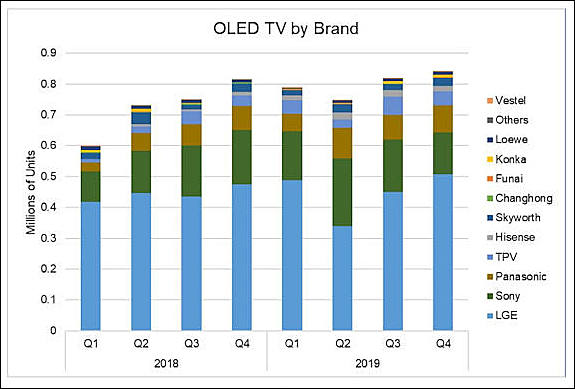

 sa11496.jpg575 x 389 - 38K
sa11496.jpg575 x 389 - 38K -
BOE is launching the OLED production lines this year which will essentially boost its manufacturing capacity by more than 200 percent. Recently, the company has heavily invested in three OLED production lines in China. The first is in Chengdu which is also the first flexible AMOLED production line within China. It will produce the sixth generation of AMOLED displays and will reach a full production capacity of manufacturing 48,000 units every month.
-
LG Display formally celebrated Thursday the start of full mass production of OLED TV panels from its 8.5 Gen OLED panel fab in Chinese Guangzhou. Fab is currently producing 70,000 sheets per month, and “based on these two production bases, the company is fully prepared to further accelerate the trend of large-size OLED displays.”.
Howdy, Stranger!
It looks like you're new here. If you want to get involved, click one of these buttons!
Categories
- Topics List23,991
- Blog5,725
- General and News1,354
- Hacks and Patches1,153
- ↳ Top Settings33
- ↳ Beginners256
- ↳ Archives402
- ↳ Hacks News and Development56
- Cameras2,367
- ↳ Panasonic995
- ↳ Canon118
- ↳ Sony156
- ↳ Nikon96
- ↳ Pentax and Samsung70
- ↳ Olympus and Fujifilm101
- ↳ Compacts and Camcorders300
- ↳ Smartphones for video97
- ↳ Pro Video Cameras191
- ↳ BlackMagic and other raw cameras116
- Skill1,960
- ↳ Business and distribution66
- ↳ Preparation, scripts and legal38
- ↳ Art149
- ↳ Import, Convert, Exporting291
- ↳ Editors191
- ↳ Effects and stunts115
- ↳ Color grading197
- ↳ Sound and Music280
- ↳ Lighting96
- ↳ Software and storage tips266
- Gear5,420
- ↳ Filters, Adapters, Matte boxes344
- ↳ Lenses1,582
- ↳ Follow focus and gears93
- ↳ Sound499
- ↳ Lighting gear314
- ↳ Camera movement230
- ↳ Gimbals and copters302
- ↳ Rigs and related stuff273
- ↳ Power solutions83
- ↳ Monitors and viewfinders340
- ↳ Tripods and fluid heads139
- ↳ Storage286
- ↳ Computers and studio gear560
- ↳ VR and 3D248
- Showcase1,859
- Marketplace2,834
- Offtopic1,319




